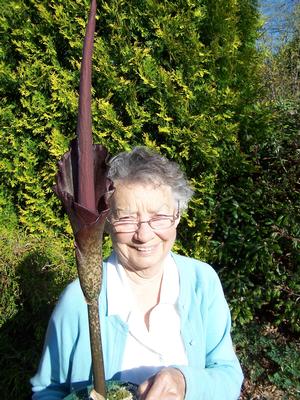View All Plants :: View All BULBS :: View All TENDER PERENNIALS
Amorphophallus konjac
Voodoo Lily
Plant Type:
BULBSAmorphophallus konjac (syn. A. rivieri) (ex: Jonathan Lehrer) – Amorphophallus konjac Is among the easiest Devil's Tongue or Voodoo Lily to grow; it is a good starting plant for any and all interested in this fascinating genus in the bizarre and fabulous aroid complex. From the flattened round tuber which will grow to about 10 inches in diameter arises a fleshy green stem spotted brown. Foliage is tropical looking and dichotomous looking bi-pinnately compound. When mature enough a wild, bizarre and large (to 2 feet tall) dusky red-purple-brown malevolent spathe flower smelling of rotten meat blossoms on a stem that may rise as high as 5 feet – a flower that only Morticia Addams would embrace; although admittedly we find them mesmerizing, fascinating and exotic - no texture quite like 'em! This is a food plant in various parts of Asia; it also has laxative, cleansing and satiety properties. Easy to grow in large containers in the north it is a tropical to subtropical plant that appreciates a fertile moisture retaining soil which has been amended with organic matter. Grow it in shade or dappled conditions sheltered from wind. At the end of the growing season place it in a cool corner in your basement or under a bench if you have a cool greenhouse. Water less when dormant. Potted bulb.
From Teasie B. (KY) on 6.19.2014
Wayne,
I received my plants [Amorphophallus konjac] yesterday and they are in the ground. They were absolutely perfect and I am so happy with my order. i had these plants and last winter i lost all of them except for one and was devastated. I was so happy that i had found those through your nursery. Thank you so much.
Teasie
Characteristics and Attributes for Amorphophallus konjac
Season of Interest (Flowering)
- Summer
Season of Interest (Foliage)
- Spring / Summer / into Autumn
Light
- Morning Sun / Afternoon Shade
- Dappled Shade
- Shade
Attributes
- Greenhouse / Alpine House
- Massing
- Natural Garden
- Potted Plant
- Woodland
Growth Rate in the Garden
- Medium
Soil
- Humus Laden
- Average
- Organic
- Moist
- Woodland
- Fertile
- Acid
Origins
- China
- Vietnam
Propagated By
- Offset
Genus Overview: Amorphophallus
Amorphophallus as a genus is among the odder, darker of the amazing and perpetually fascinating aroid group. Flowers are fleshy vases (spathes) with a fat, vertical tongue (spadix) emerging from the center of the wrap. Most species smell of decaying flesh though not all. The curious flowers coupled with the foetid odor adds to their dark allure. The malodorous quality evolved to draw the insects that perform the pollination service.
Foliage is large, showy and complex - a beautiful complement to more delicately-leaved companions or in a bold stroke a fine contrast to large, in-your-face simple leaves.
Older bulbs of some species become concave at the top which turns them into shallow bowls which can collect water. More so towards the northern end of the range this can be damaging as cold, icy water can contribute to rot. Digging the bulbs and keeping them in the cool corner of a basement or the like won't set them back. Or digging down and turning them on their sides and re-covering them for the long winter's nap is also a way to care for your charge. Ours remain potted in one of our cool greenhouses. If potted water less when dormant.
Easy to grow in large containers in the north it is a plant found in the warmer temperate regions with a number of tropical species. Most will appreciate a fertile moisture retaining soil which has been amended with organic matter. Grow it in shade or dappled conditions sheltered from wind.
We find all the aroids fascinating, primitive, oddly alluring, curious, with some - those emitting dangerous scent exude lurid malevolence. They mesmerize with their primitive presence.


